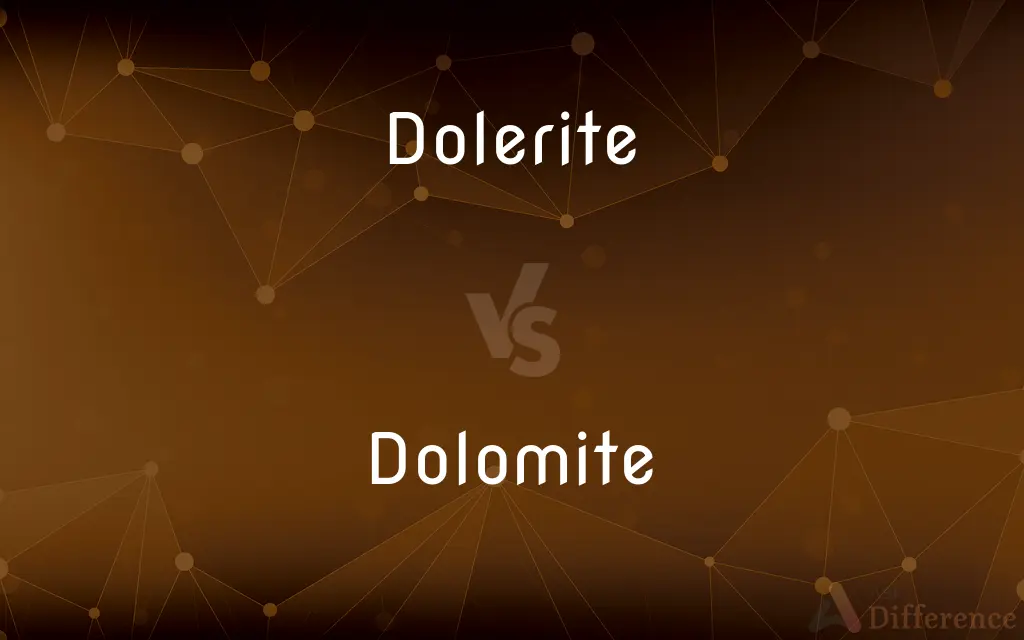Dolerite vs. Dolomite — What's the Difference?
By Urooj Arif & Fiza Rafique — Updated on March 4, 2024
Dolerite is a medium-grained, igneous rock known for its hardness, while dolomite is a sedimentary carbonate rock, valued for its mineral content and use in construction.

Difference Between Dolerite and Dolomite
Table of Contents
ADVERTISEMENT
Key Differences
Dolerite, also known as diabase, is an igneous rock that forms from the rapid cooling of basaltic lava exposed at or very near the surface of our planet. This process results in a medium-grained texture, with a composition rich in plagioclase feldspar and pyroxene. On the other hand, dolomite is a sedimentary rock composed primarily of the mineral dolomite (calcium magnesium carbonate). It forms when limestone undergoes a chemical change, often as a result of magnesium-rich fluid seeping through the limestone.
Dolerite is known for its hardness and durability, making it suitable for use in construction, especially for road and building foundations. Dolomite rock is used in construction where its chemical stability and strength are advantageous, and it is also burned to produce dolomitic lime, a valuable material in the steel industry.
Dolerite's significance lies in its structural integrity, providing a strong foundation material that is less susceptible to weathering compared to many other rocks. This characteristic is especially valued in the construction of heavy structures and infrastructure. Conversely, dolomite's appeal comes from its dual role as both a construction material and a source of magnesium and lime. Its unique chemical properties make it suitable for specialized applications, including the production of refractory bricks used in high-temperature environments.
While dolerite is primarily valued for its physical properties and strength, dolomite is appreciated for its chemical composition and versatility. Dolerite is extracted from quarries where it is cut into manageable sizes for construction purposes. In contrast, dolomite is often mined for its mineral content, with its extraction focusing on maximizing purity and quality for industrial uses.
One of the key differences between the two rocks is their formation process. Dolerite's igneous origins involve the cooling and solidification of magma or lava, giving it a dense and cohesive structure. Dolomite's sedimentary origins, involving the alteration of limestone by magnesium-rich fluids, result in a rock with distinct mineral properties and uses. This difference in formation contributes to their varied applications in industry and construction.
ADVERTISEMENT
Despite their differences, both dolerite and dolomite play crucial roles in their respective domains. Dolerite's strength and durability make it indispensable in construction projects requiring robust materials. Meanwhile, dolomite's chemical properties and versatility extend its use beyond construction to include agricultural and industrial applications, showcasing the diversity and utility of rock materials in various sectors.
Comparison Chart
Type
Igneous rock
Sedimentary rock
Composition
Primarily plagioclase feldspar and pyroxene
Composed of the mineral dolomite (CaMg(CO3)2)
Formation
From the rapid cooling of basaltic lava
From chemical alteration of limestone
Texture
Medium-grained
Often fine to coarsely crystalline
Hardness
Hard and durable
Relatively hard and chemically stable
Uses
Construction, road and building foundations
Construction, dolomitic lime production, refractory bricks
Chemical Properties
Not rich in magnesium or calcium
Rich in magnesium and calcium
Mining
Quarried for construction material
Mined for mineral content and industrial use
Industrial Applications
Less varied, mainly construction
Diverse, including agriculture and steel industry
Environmental Resistance
High resistance to weathering
Chemical stability in various conditions
Compare with Definitions
Dolerite
Known for its strength and resistance to weathering.
The ancient dolerite columns have withstood centuries of erosion.
Dolomite
A sedimentary rock containing the mineral dolomite.
Dolomite cliffs offer a stunning backdrop for hikers.
Dolerite
A hard, igneous rock formed from cooled basaltic lava.
Dolerite is often used for constructing durable roadways.
Dolomite
Forms from the alteration of limestone.
Over geological time, limestone regions can transform into dolomite landscapes.
Dolerite
Used in heavy construction due to its durability.
Dolerite serves as a foundation for many modern skyscrapers.
Dolomite
Mined for its versatile industrial applications.
Dolomite mining supports various sectors, including construction and agriculture.
Dolerite
Quarried for its physical properties.
The dolerite quarry supplies rock for numerous construction projects.
Dolomite
Used in the production of dolomitic lime.
Dolomite is essential in refining processes in the steel industry.
Dolerite
Medium-grained texture with a dark appearance.
Dolerite's unique texture makes it a preferred material for certain architectural features.
Dolomite
Valued for its chemical stability and magnesium content.
Farmers use dolomite to neutralize acidic soils.
Dolerite
A dark, crystalline, igneous rock, chiefly pyroxene with labradorite.
Dolomite
(mineral) An evaporite consisting of a mixed calcium and magnesium carbonate, with the chemical formula CaMg(CO3)2; it also exists as the rock dolostone.
Dolerite
A dark, fine-grained igneous rock; diabase.
Dolomite
A white or light-colored mineral, essentially CaMg(CO3)2, used in fertilizer, as a furnace refractory, and as a construction and ceramic material.
Dolerite
(geology) A type of fine-grained basaltic rock.
Dolomite
A magnesia-rich sedimentary rock resembling limestone.
Dolomite
A mineral consisting of the carbonate of lime and magnesia in varying proportions. It occurs in distinct crystals, and in extensive beds as a compact limestone, often crystalline granular, either white or clouded. It includes much of the common white marble. Also called bitter spar.
Dolomite
A kind of sedimentary rock resembling limestone but consisting almost entirely of the mineral dolomite
Dolomite
A light colored mineral consisting of calcium magnesium carbonate; a source of magnesium; used as a ceramic and as fertilizer
Common Curiosities
Are there any environmental benefits to using dolomite?
Yes, dolomite can neutralize acidic soils, making it beneficial for agricultural use.
What distinguishes dolerite from dolomite?
Dolerite is an igneous rock known for its physical strength, while dolomite is a sedimentary rock valued for its chemical properties.
What makes dolomite significant in the steel industry?
Dolomite is burned to produce dolomitic lime, crucial for steel refinement and production processes.
How does the mining of dolerite compare to that of dolomite?
Dolerite is quarried primarily for construction, while dolomite mining focuses on extracting high-quality mineral content for diverse uses.
How do the formation processes of dolerite and dolomite differ?
Dolerite forms from the cooling of basaltic lava, while dolomite forms from the chemical alteration of limestone.
What is the significance of dolerite's texture in its applications?
Its medium-grained texture contributes to its strength and durability, making it suitable for construction.
Can dolomite be used for construction purposes?
Yes, its chemical stability and strength make it suitable for construction, especially where chemical resistance is needed.
How is the quality of dolerite and dolomite assessed for industrial use?
Quality is determined by physical properties for dolerite and chemical composition for dolomite, depending on the intended application.
How is dolerite used in construction?
It's used for its durability and resistance to weathering, especially in road and foundation construction.
Can dolomite rock contain fossils?
Yes, as a sedimentary rock, dolomite can contain fossils, unlike the igneous dolerite.
What role does dolomite play in agriculture?
It's used to correct soil pH and add magnesium, a necessary nutrient for plant growth.
Is dolerite or dolomite more resistant to weathering?
Dolerite tends to be more resistant due to its igneous nature and dense structure.
How do the chemical properties of dolerite and dolomite impact their use?
Dolerite's lack of chemical properties makes it ideal for structural uses, while dolomite's rich magnesium and calcium content broadens its industrial applications.
Why is dolomite preferred in certain construction applications?
Its chemical stability and strength under various conditions make it suitable for environments requiring durability against chemical erosion.
What environmental considerations exist for mining dolerite and dolomite?
Both require sustainable mining practices to minimize environmental impact, with dolomite mining also focusing on preserving the chemical quality of the rock.
Share Your Discovery

Previous Comparison
Waitress vs. Server
Next Comparison
Though vs. HardAuthor Spotlight
Written by
Urooj ArifUrooj is a skilled content writer at Ask Difference, known for her exceptional ability to simplify complex topics into engaging and informative content. With a passion for research and a flair for clear, concise writing, she consistently delivers articles that resonate with our diverse audience.
Co-written by
Fiza RafiqueFiza Rafique is a skilled content writer at AskDifference.com, where she meticulously refines and enhances written pieces. Drawing from her vast editorial expertise, Fiza ensures clarity, accuracy, and precision in every article. Passionate about language, she continually seeks to elevate the quality of content for readers worldwide.















































